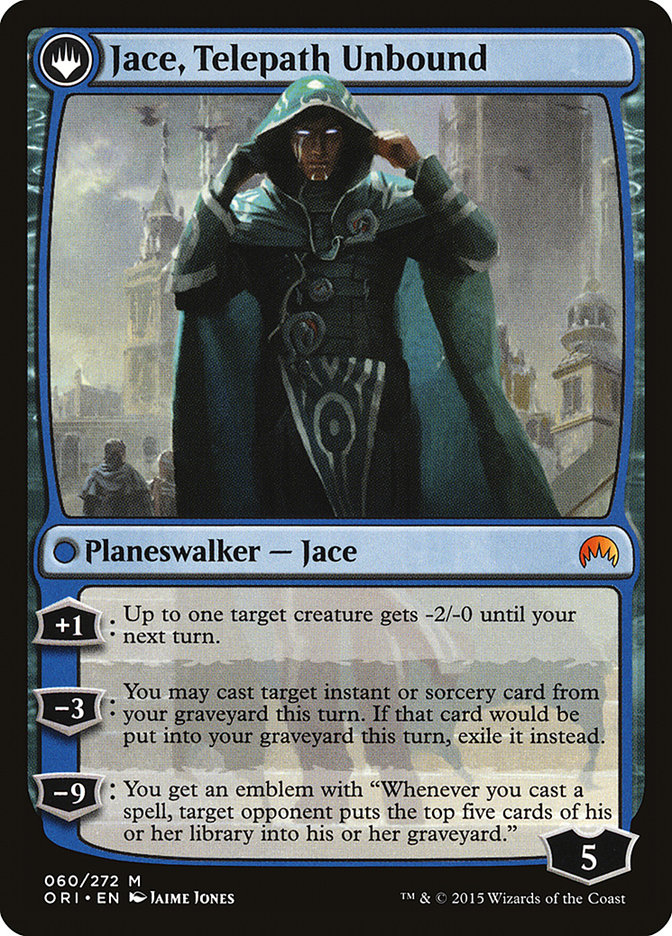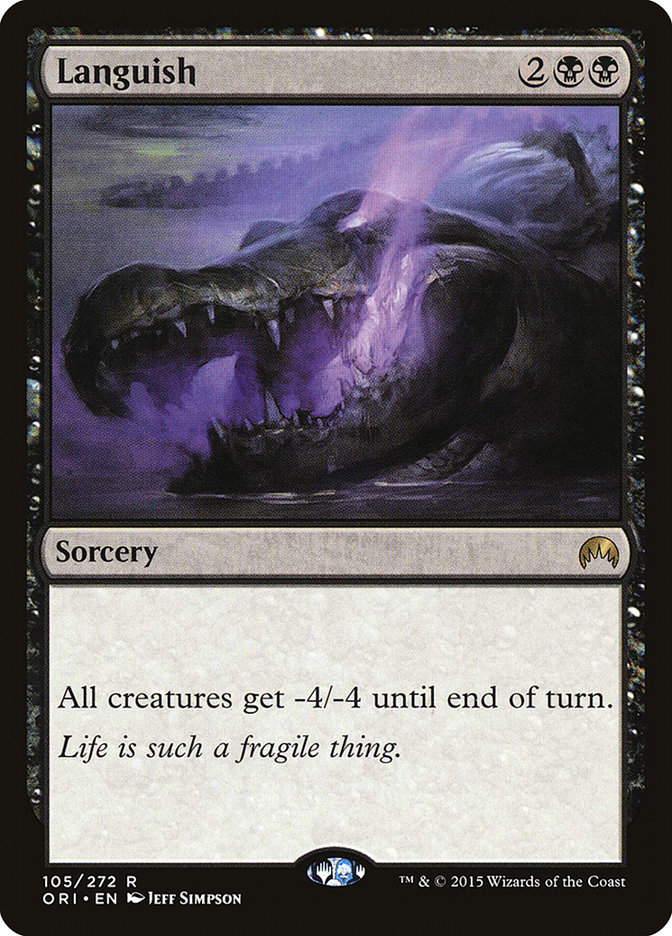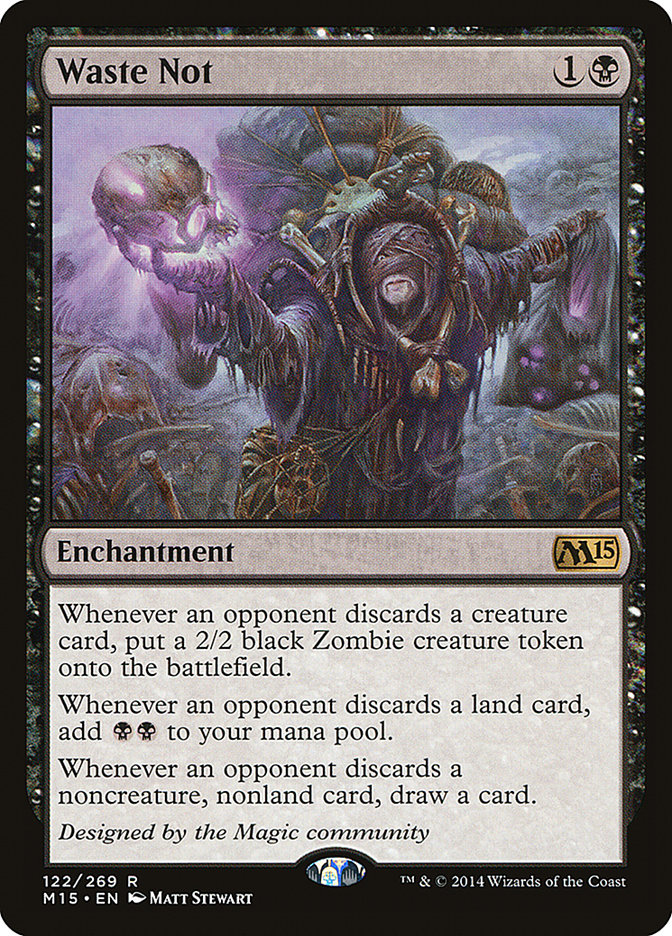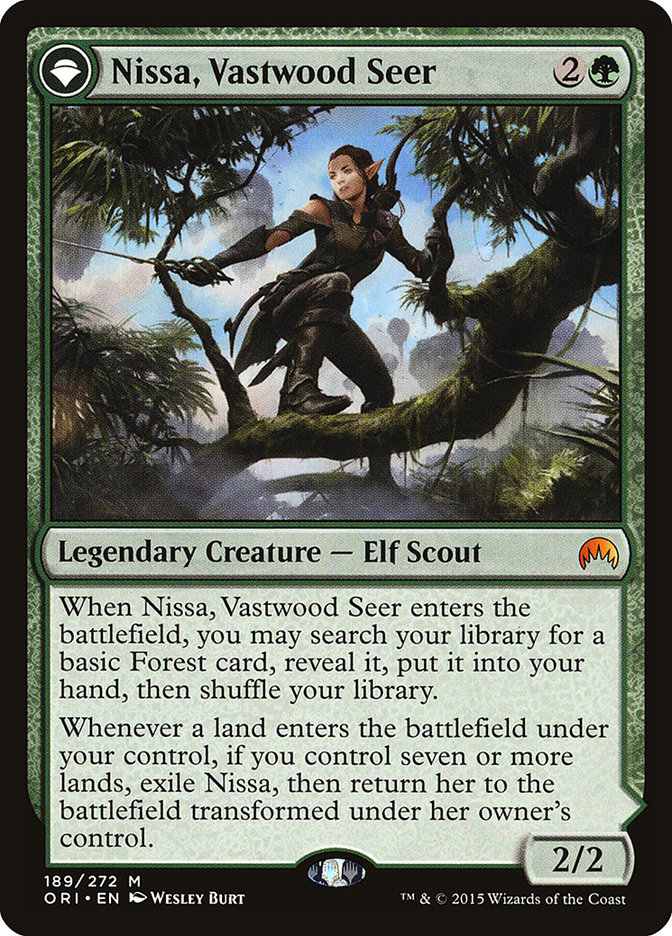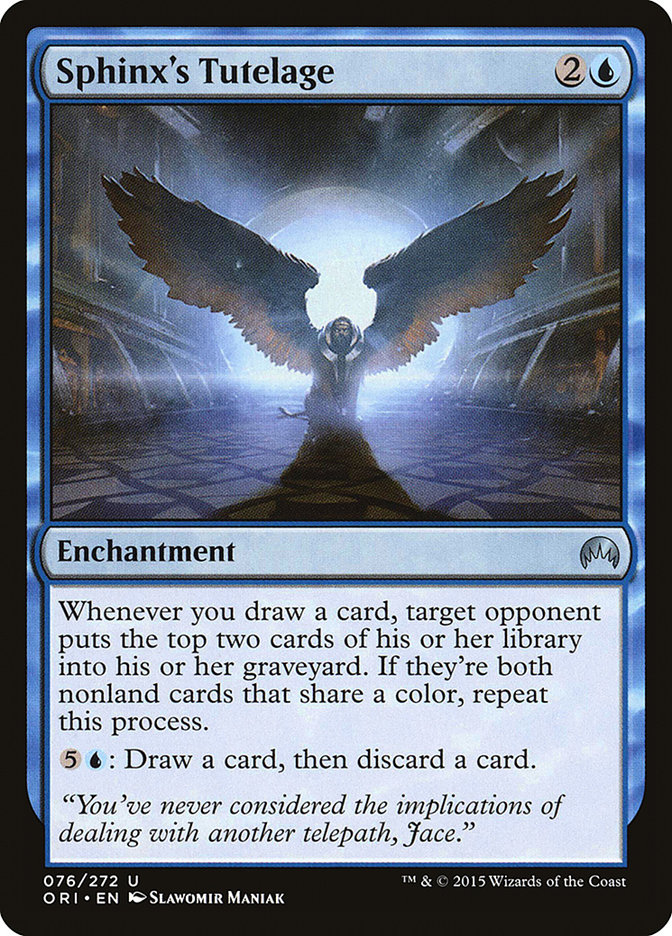The first Standard Open featuring Magic Origins was held in Chicago last weekend. If you watched the coverage, you saw a lot of great ideas featuring the new set, though the Top Sixteen gives us an entirely different story. The best decks rose to the top of the standings, but there is so much more lying beneath the surface. Standard is not just G/R Devotion. Three copies of the deck made it to the Top Eight and those three pushed themselves into the Top Four – and won – because they are affected the least by the new set. G/R Devotion required the least work to tune because it has been around for so long.
New ideas are often overshadowed by pre-existing decks or strategies. We understand them better, and can make calculated decisions about building those decks much more easily. It takes some time and a lot of work to make a new strategy into a powerhouse, but the Standard Open in Chicago gave us a glimpse at some new archetypes. It also gave us a great look at which cards out of Magic Origins are going to make a significant impact.
Ideas Unbound
I, for one, have become a believer in this little guy.
Merfolk Looter has been in and out of Standard for a long time, and it is rarely a bad card. It usually needs some way to turn the graveyard into a resource, but using the graveyard to your advantage isn’t exactly difficult. At this point in Standard we have all found powerful and interesting ways to use the Delve mechanic, but the new Jace has a built-in way to utilize any card it discards later in the game, acting like Snapcaster the Planeswalker.
I was very impressed with Jace, Vryn’s Prodigy in all manner of Jeskai decks, but it is also the only thing holding this monstrosity together:
Creatures (30)
- 4 Nantuko Husk
- 4 Elvish Mystic
- 3 Sylvan Caryatid
- 2 Mogis's Marauder
- 4 Satyr Wayfinder
- 3 Grim Haruspex
- 2 Den Protector
- 3 Deathmist Raptor
- 1 Liliana, Heretical Healer
- 4 Jace, Vryn's Prodigy
Lands (20)
Spells (10)

So many moving pieces, it is tough to know where to start. For one, beating an artifact creature is tough. Intimidate from Mogis’s Marauder can only get you so far, and I wouldn’t be surprised if more control strategies decided to adopt Hangarback Walker. The card looks and feels pretty good, and is likely the closest thing to Doomed Traveler we’re ever going to have again. The upside is that it can grow to an enormous size and you don’t really mind casting End Hostilities with it on the battlefield.
Older variations of the Rally the Ancestors deck were less vulnerable to random stuff but also much less explosive. I think a hybrid of the two, featuring some Gray Merchant of Asphodel action alongside Nantuko Husk, could end up being a contender. But the current version wouldn’t even be remotely possible without Jace, Vryn’s Prodigy.
The ability to fill your graveyard with extra creatures is fantastic because that is exactly where you want them. No one wants to cast Mogis’s Marauder, except that guy Chad at your local shop who can’t stop playing Mono-Black Humans. But you can also use Jace’s flip side to your advantage. With Satyr Wayfinder and Gather the Pack in your deck you’re going to mill over Rally the Ancestors quite a bit, and Jace can be your way to cast it without actually drawing it.
But from what I gathered in Chicago, Matthew Tickal didn’t have a lot of time or help in building this deck. From what I heard, it was an Abzan deck until the Friday before, at which time he jammed four copies of Jace into the deck and changed the mana to support it. To say the manabase is “aggressive” would be an understatement. After playing just a few games with the current list, I’ve picked up on some places that can be improved.
A deck featuring small black creatures or Thopters makes it nearly impossible to combo off with your Nantuko Husk attacking. An easy fix that could help the deck is adding some number of Minister of Pain. The exploit could help alleviate many problems the deck has, and being a Chord of Calling deck means you don’t need to play many. It also has a lot of upside against Jeskai Tokens and various Atarka Red builds, sweeping the board of annoying threats.
Aside from the minor problems the combo faces, there are others that need to be addressed inside the list itself. The sideboard is a joke. The lack of Murderous Cut means you’re going to straight-up lose to Anafenza, the Foremost. The fifth color for Kolaghan’s Command seems egregious. I honestly don’t “get” Deathmist Raptor, or why there are only three copies of Sylvan Caryatid. And that’s just what I can think of off the top of my head.
I’m not poking fun at Tickal. I’m saying that these are errors that we all make when building a new deck. At Pro Tour Magic Origins, Rally the Ancestors might be the best thing in the room. It looks to have a solid matchup against G/R Devotion, which will be a giant factor in determining what deck to play. But while it isn’t quite ready for the big time, all it takes is a few days and a few great minds to put the pieces of the puzzle together. Whether or not we see this deck break out at the Pro Tour in questionable, as it is a dangerous (and large) project to tackle. I’m going to assume that most of the big teams will play it safe with a known archetype featuring some new goodies and focus mostly on breaking Limited. At the very least, that’s what I would do.
Sweep ‘Em Under The Rug
Moving on, there was one other card that saw heavy play in an established archetype.
That archetype, of course, was this:
Creatures (15)
Planeswalkers (3)
Lands (26)
Spells (16)

This is my pick for best card from Magic Origins. Black decks get a maindeckable Wrath effect that doesn’t kill all of its creatures. Siege Rhino and Tasigur, the Golden Fang see a lot of play already, but both survive Languish while forcing your opponent to overextend. If they don’t progress their board, some spot removal spells should clear the way long enough for them to take over the game. But that’s the beauty of a card like Languish, and Crux of Fate before it. Sweeper effects that don’t kill your own creatures are great for midrange strategies. They allow you to progress your board instead of sitting on your hands and waiting for your opponent to make the first move.
Languish is also a phenomenal card for combating some of the serious problem cards that were heavily played before Magic Origins. Anafenza, the Foremost, Fleecemane Lion, Rakshasa Deathdealer, and Dragonlord Ojutai saw a ton of play before Magic Origins, but I feel like their impact will be lessened with Languish running around. It was easy for Abzan Control to adopt this tool, and it gives them the ability to deal with certain creatures that previously had given them a lot of trouble.
Languish also makes Whisperwood Elemental a bit worse, though it does still have built-in protection from sweeper effects. The good news is that Abzan Control doesn’t have much of a problem beating a few Manifest creatures. Killing all Coursers and mana accelerants from Devotion is pretty huge for Abzan, and it isn’t like they can really play around it. After all, mana accelerants aren’t great in the lategame.
I don’t think we’ve fully begun to appreciate the scope at which Languish changes the metagame. Some archetypes were pushed fully out of the picture while others had to keep Languish in mind when building their deck to begin with. And the sheer fact that we’ve only seen Languish alongside Siege Rhino and Tasigur means we’ve only begun to scratch the surface. I love the fact that most of the big, black, Delve creatures have five toughness. Gurmag Angler and Tasigur both pair nicely with Languish. That means we just need to find them all a good home.
I’m not the one to build it right, but here’s something of a start.
Creatures (9)
Lands (23)
Spells (28)
- 3 Thoughtseize
- 2 Ultimate Price
- 3 Hero's Downfall
- 4 Waste Not
- 4 Treasure Cruise
- 4 Rakshasa's Secret
- 4 Dark Deal
- 3 Languish
- 1 Dark Petition
Sideboard

I haven’t had a chance to play with the deck since Magic Origins was released, but I’ve had this in the back of my mind for a few weeks now. Dark Deal plus Waste Not is a powerful combo against slower decks, and it is especially strong against people sitting on a hand full of removal spells. If you’re able to assemble the combo quickly, it is devastating for the opponent. Chaining multiple copies of Dark Deal together from the excess mana generated by Waste Not will leave the opponent with very few resources while you pile on more Zombies and end with a full grip of cards.
On top of that, Dark Deal helps to fuel Delve, allowing you to play finishers like Gurmag Angler and Tasigur with ease. Treasure Cruise is also a powerful spell in this style of deck since your main goal is attrition of all resources. Jace, Vryn’s Prodigy is also great in this deck since you can keep him in Merfolk Looter mode as long as you want to thanks to Delve or flip him to start re-casting removal spells, discard, or just another Dark Deal.
I’m also pretty excited to see what Dark Petition can do. This deck seems like the perfect shell for a Tutor-and-Ritual effect. You would pay extra mana for additional copies of both Waste Not and Dark Deal, so it seems only fitting to play at least one copy of Dark Petition. You must be careful with Delve, as it turns off Spell Mastery if used incorrectly, but we’re trying to use all the parts of the buffalo here.
While this deck got a bit of press when it was first debuted by Antonino de Rosa, it was a bit too gimmicky for my tastes. But Languish alongside so many big Delve threats seems incredibly powerful. If this deck is firing on all cylinders, it probably doesn’t even need the Dark Deal–Waste Not combo to win the game. Removal, discard effects, card draw, and a win condition has been working just fine for Abzan Control. This deck does it a bit differently, but it can attack from a completely different angle against the slower decks in the format.
I don’t know if this Dark Deal deck can compete yet with the top decks in the current Standard format, but the core of the idea is sweet. Again, it will take more eyes and hands on the deck before it could become part of the metagame, but I’m confident it could be a player with the downswing in popularity of Dromoka’s Command.
On The Border(land)
While Jace and Languish were the big winners in Chicago, there were a few other cards that got some of the spotlight. Namely, my boo Nissa.
Nissa’s impact on green decks was fairly widespread, but I think the overall opinion of her from people I talked to was that it was “fine.” I wasn’t exactly impressed with her in the G/R Devotion deck, but she was certainly good for one thing: making sure you hit your land drops. While Nissa was fine in Devotion, I’m sure she was much stronger in a more-controlling shell like Abzan.
The one thing about ramp strategies is that drawing a bunch of cards doesn’t amount to much. Your deck is full of excess mana sources, so drawing one or two extra cards might not do anything to help you win the game. This makes the planeswalker side of Nissa less appealing for a deck like G/R Devotion. But drawing a lot of cards in Abzan Control is fantastic, and I could see her being a much bigger player in that deck than in G/R Devotion.
G/R Devotion is also pretty bad at playing the aggressive role. You don’t usually win with incremental damage, rather you win in one fell swoop once you’ve established a huge mana or threat dominance. The 4/4 Elemental created by the back side of Nissa isn’t all that impressive when you’ve already been casting Polukranos and Whisperwood Elemental. Hitting seven lands in G/R Devotion is also not that easy. You are much more focused on hitting seven mana in general to start casting Dragonlord Atarka or big Genesis Hydras, making mana creatures much more appealing than doing things the old fashioned way.
But Abzan doesn’t usually play mana creatures and it does want to hit all of its land drops for the first seven or so turns. Nissa can help it do that while also providing the Abzan Control player with a draw engine that is easy to protect via creatures and removal spells. I saw Nissa dominate games in the hands of Abzan Control pilots every time she was able to flip. But when you’re just turning over your third Sylvan Caryatid from Nissa, it is much less exciting.
Another card that was making some waves at the tournament was a new take on the classic Millstone strategy.
Out of both Jeskai Tokens and Turbo Fog, Sphinx’s Tutelage did some serious work. It is amazing how quickly you can deck someone with Sphinx’s Tutelage if they’re playing a mono-colored deck, but you also get a lot of triggers from it thanks to Jeskai Ascendancy, Treasure Cruise, and even Dictate of Kruphix. While the Turbo Fog deck didn’t make it to the second day of competition, it did garner a lot of attention on camera on Day One because it was so unique compared to the rest of the format.
Lands (24)
Spells (37)

I ended up facing James Newman in round eight of the tournament at 7-1, and I can’t stress enough just how helpless I felt in the first game. He drew so many cards, and I had no alternate route to victory outside of attacking. And Sphinx’s Tutelage seemed like an easy way for him to close the game.
However, I was able to defeat James in the next two games thanks to Shaman of Forgotten Ways, which we had played as a card to gain an edge in the mirror. The extra mana from a single creature could turn the tide in a ramp-on-ramp matchup, allowing you to play Dragonlord Atarka a turn earlier than your opponent. But I honestly had more success using the “Biorhythm” mode of Shaman of Forgotten Way to win multiple games.
The fact that this version of Turbo-Fog couldn’t deal with a creature on the battlefield outside of Aetherspouts was a major hole in its game, and though I don’t expect Shaman of Forgotten Ways to catch on as an auto-include in G/R Devotion there was a Dragonlord Dromoka sighting that could be a serious problem for that plan. There are a lot of ways to disrupt the Turbo Fog deck. Being able to kill their enchantments is huge, and something like Back to Nature is an absolute nightmare. Negate and other counterspells can protect you from that, but it might be too much to ask if you’re facing down Abzan Control with a ton of discard spells, threats that need to be fogged, and Disenchant effects.
In an alternate universe where Brad and I don’t play Shaman of Forgotten Ways, James Newman could very well have gone on to win this tournament.
But Jeskai Tokens is still a thing, and ended up punching through to the Top Eight in the hands of Kevin McLeskey.
Creatures (8)
Lands (24)
Spells (28)
- 3 Raise the Alarm
- 1 Dragon Fodder
- 2 Lightning Strike
- 4 Stoke the Flames
- 4 Treasure Cruise
- 4 Hordeling Outburst
- 4 Jeskai Ascendancy
- 3 Wild Slash
- 2 Ojutai's Command
- 1 Secure the Wastes
Sideboard

I’ve talked about the potential of Ojutai’s Command alongside Jace, Vryn’s Prodigy before, but Kevin almost took it to the finish line. This version could potentially have problems with bigger creatures since it isn’t playing any copies of Roast or Valorous Stance in the maindeck, but I don’t mind ignoring big creatures in the first game. The odds of your opponent being able to sweep your board or overwhelm you before you get Jeskai Ascendancy going is small, which is why Jeskai Tokens has such a good Game One win percentage. The addition of Jace only makes it better in my eyes.
The Sphinx’s Tutelage in the sideboard here give Jeskai Tokens an alternate route to victory over any opponent who wants to sweep your tokens over and over with stuff like Languish and Drown in Sorrow. It is also a great win condition against a control deck since they will likely have very few ways of actually killing it. At the moment, enchantment hate is at an all-time low, which might make a Jeskai Tokens comeback a reality. But the heavy play of Languish out of Abzan Control could ultimately spell disaster. My recommendation is to play it safe against them. Treasure Cruise and Jeskai Ascendancy are powerful ways to recoup losses, but you’ll likely be on the back foot for most of the game since you don’t have a lot of answers to Siege Rhino.
Get Rich(mond) Or Die Trying
This weekend, the Open Series is going to Richmond for the second Standard Open featuring Magic Origins. I’ll be in attendance, but I’m unsure right now just what I’ll be playing. There are so many options, but it is important that you keep G/R Devotion at the forefront of your mind when deciding what deck to play. If your deck can’t beat it, then you should probably work on solving that problem or moving on to a new deck.
I’m currently leaning towards Dark Deal, as it has been a long time since I’ve had any real fun in Standard and just playing “the best deck” from week to week hasn’t exactly worked out in my favor. Jeskai Tokens could be my next best option, but I wouldn’t be surprised if people came packing some serious hate for it. With red decks and Goblin Piledriver on the incline in Standard, sweeper effects are getting better by the second. Playing a deck that runs head-on into sweepers isn’t exactly where I want to be, but it might just be powerful enough to fight through all of that stuff.
Treasure Cruise is still a hell of a card.


